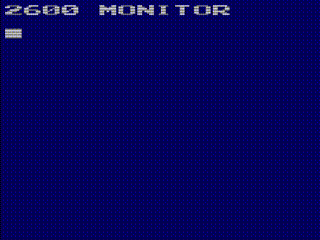Ecosyste.ms: Awesome
An open API service indexing awesome lists of open source software.
https://github.com/dadecoza/atari2600-monitor
a Machine Code/Language Monitor for the Atari 2600
https://github.com/dadecoza/atari2600-monitor
Last synced: 10 days ago
JSON representation
a Machine Code/Language Monitor for the Atari 2600
- Host: GitHub
- URL: https://github.com/dadecoza/atari2600-monitor
- Owner: dadecoza
- License: mit
- Created: 2023-06-19T22:30:12.000Z (over 1 year ago)
- Default Branch: main
- Last Pushed: 2023-06-22T11:27:42.000Z (over 1 year ago)
- Last Synced: 2023-12-15T00:43:45.679Z (11 months ago)
- Language: Assembly
- Size: 1.71 MB
- Stars: 1
- Watchers: 1
- Forks: 0
- Open Issues: 0
-
Metadata Files:
- Readme: README.md
- License: LICENSE
Awesome Lists containing this project
README
# atari2600-monitor
a Machine Language Monitor for the Atari 2600

This is Steve Wozniaks Woz Monitor ported to the Atari 2600. For general information and usage of Wozmon you can checkout the excelent post on [SB-Projects](https://www.sbprojects.net/projects/apple1/wozmon.php) page.
## Cartridge
The cartridge makes use of the Commavid (CV) mapper.
```
CV Commavid
-----
This was used by Commavid. It allowed for both ROM and RAM on the cartridge,
without using bankswitching. There's 2K of ROM and 1K of RAM.
2K of ROM is mapped at 1800-1FFF.
1K of RAM is mapped in at 1000-17FF.
The read port is at 1000-13FF.
The write port is at 1400-17FF.
```
From: http://blog.kevtris.org/blogfiles/Atari%202600%20Mappers.txt
## Keyboard controller layout
The atari2600-monitor makes use of a standard CX50 keyboard controller.

The Layouts is as follows ...
### Normal
| | | |
|---|---|---|
| 1 | 2 | 3 |
| 4 | 5 | 6 |
| 7 | 8 | 9 |
|ALT| 0 |CR |
### Alt
| | | |
|---|---|---|
| A | B | C |
| D | E | F |
| . | : | R |
|ALT|BS |CR |
### Key functions
* 0123456789ABCDEF hex digits
* *.* Examine memory location
* *:* Store to memory Location
* *R* Run from last memory location
* *ALT* Switch between keyboard layouts
* *BS* Backspace
* *CR* Enter
## Examples
### Change the background colour by writing to the TIA COLUBK register ...
```
009:30
```
Keyboard controller key presses ...
```
0 0 9 * 8 * 3 0 #
```
Stella Emulator key presses ...
```
x x d z s z 3 x c
```
### Print HELLO WORLD
This example make use of the monitors subroutines to print "HELLO WORLD"
```
1 f015 PROCESSOR 6502
2 f015 00 a5 MsgPtr EQU $a5
3 f015 fc d6 PrintMsg EQU $fcd6
4 f015 fd c0 Done EQU $fdc0
5 f000 org $F000
6 f000 a9 0e LDA #data
9 f006 85 a6 STA MsgPtr+1
10 f008 20 d6 fc JSR PrintMsg
11 f00b 4c c0 fd JMP Done
12 f00e 04 19 16 1d*data .byte.b #$04, #$19, #$16, #$1d, #$1d, #$20, #$07 ; \nHELLO WORLD\0
13 f015 28 20 23 1d* .byte.b #$28, #$20, #$23, #$1d, #$15, #$00
```
Although we will be running the example from memory location F000 we will have to enter the program at memory location F400 the reason for this is that we are using
the A10 address line as "write enable" on the SRAM IC (we do not have the luxury of a write pin on the cartridge port). After the program is typed in we will then examine memory location F000 followed by the "R" command. ...
```
F400
:A9
:0E
:85
:A5
:A9
:F0
:85
:A6
:20
:D6
:FC
:4C
:C0
:FD
:04
:19
:16
:1D
:1D
:20
:07
:28
:20
:23
:1D
:15
:00
F000
R
```